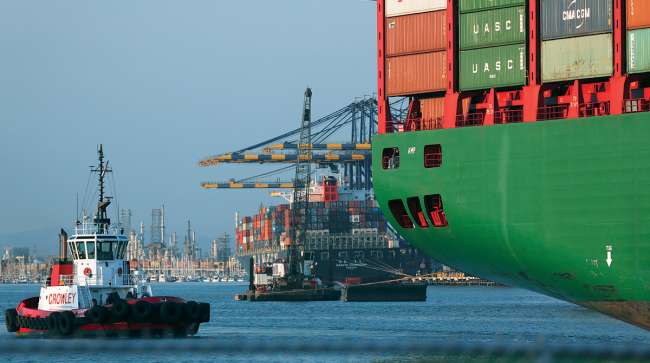Senior Reporter
NRF Seeks Meeting With Biden Over Port Congestion Issues

[Stay on top of transportation news: Get TTNews in your inbox.]
Congestion and delays in the supply chain continue to be a major headache for the nation’s retailers and now the National Retail Federation has asked President Joe Biden for a face-to-face meeting to discuss what can be done to improve the long delays.
“The supply chain disruption issues, especially the congestion affecting our key maritime ports, are causing significant challenges for America’s retailers. The congestion issues have not only added days and weeks to our supply chains but have led to inventory shortages impacting our ability to serve our customers,” NRF President Matt Shay said June 14 in a letter to the president. “In addition, these delays have added significant transportation and warehousing costs for retailers.”
NRF calls on the White House to address port congestion challenges. https://t.co/O0MUVJiRKC pic.twitter.com/FoUcSqoHF3
— National Retail Federation (@NRFnews) June 14, 2021
As the economy begins to pick up speed as the COVID-19 pandemic recedes, the NRF is increasing its forecast of how much consumers will spend during the recovery. On June 9 the NRF said it now sees an increase between 10.5% and 13.5% in real spending that amounts to more than $4.44 trillion in 2021. That compares with $4.02 trillion in total retail sales in 2020.

Shay
“The economy and consumer spending have proven to be much more resilient than initially forecasted,” Shay said. “The combination of vaccine distribution, fiscal stimulus and private-sector ingenuity have put millions of Americans back to work.”
The revised forecast surpasses NRF’s initial projection of at least 6.5% growth, made in February.
“While there are downside risks related to worker shortages, an overheating economy, tax increases and over-regulation, overall households are healthier, and consumers are demonstrating their ability and willingness to spend,” he added.
The NRF-Hackett Associates monthly Global Port Tracker said the nation’s ports that it monitors handled 2.15 million twenty-foot-equivalent unit (TEUs) containers in April, the latest month for which final numbers were available. The report said it was easily the busiest month on record and it was a 33.4% year-over-year increase in container volume compared with April 2020 during the height of the pandemic.

On May 25, five people pleaded guilty to staging two accidents in New Orleans with tractor-trailers in 2017, while obtaining fraudulent financial settlements totaling more than $282,000. Is the situation surrounding fraudulent settlements getting worse or better in 2021? Host Michael Freeze talks with TT's Eric Miller and Eleanor Lamb. Hear a snippet above, and get the full program by going to RoadSigns.TTNews.com.
The May container results are expected to be reported soon. The Global Port Tracker, based on ship movements, forecast the ports would process 2.32 million containers, which would be a 51.1% year-over-year increase, and that would set another record for the largest number of containers in a single month.
“A number of vessels taken out of service when volumes were low remain in drydock while others are delayed in congested ports, which face a lack of manpower both because of COVID-19 illnesses and the tight labor market,” said Ben Hackett, founder of Hackett Associates. “Supply chains are finding it difficult to keep up with demand as shipping capacity struggles. Many people remain hesitant about returning to work, affecting ports, rail, trucking and distribution centers.”
In Shay’s letter to Biden, and other top officials, he said that 97% of retailers surveyed by the NRF say they have been impacted by the port and shipping delays. Some 70% of them said they have had to add two to three weeks to their supply chains because of the port delays.
“We continue to work with key executives at the ports and with our transportation providers,” Shay wrote. “We need strong leadership from the administration to galvanize attention to the current situation as well as work to resolve long-standing issues that limit safe and efficient port operations.”
Gene Seroka, executive director at Port of Los Angeles, said during a radio interview with Transport Topics that port congestion will likely continue to be a problem for at least the next six months, especially as facilities begin to ramp up for September when students return to school, followed by the holiday shopping season.

Seroka
“We’ve been buying a lot. We’ve diverted money from other sectors. We weren’t going to the ballgames or movies,” Seroka said. “I see the balance of this year being strong. But [first quarter] of 2022, as more of our economy is open and more people are comfortable getting back into the service sector and traveling, I think we’ll see a bit of a difference. I don’t think we’ll fall off a shelf, but we’ll see a more moderate flow into the future.”
He said the number of ships anchored in San Pedro Bay awaiting berths at either Los Angeles or the adjacent Port of Long Beach has dropped on average to the high-teens daily — down from more than 60 ships in March and April. The wait time has also declined from more than eight days to between four and six days. Still, he agrees with NRF that the ports and their workers are stressed.
“We don’t have the luxury of a couple of days or 18 hours to groom the yards for the next vessel call and get our workers prepared for the next vessel coming in,” Seroka said.
Want more news? Listen to today's daily briefing below or go here for more info:




